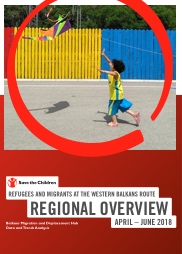
Briefs, Fact Sheets and Brochures, Study: Research
Balkans Migration and Displacement Hub Data and Trends Analysis: Regional overview (April-June 2018)
Publication year:
2018
English
Format:
pdf (1.5 MiB)
Publisher:
Save the Children North West Balkans
Data and Trend Analysis (DATA) Refugees and Migrants at the Western Balkans Route Regional Overview, covering period April-June 2018, describes key trends in migrations in the region, detailing information about the number of people on the move, demography (age, sex, country of origin, etc), behavioral patterns, and routes in use – with a focus on children, particularly unaccompanied children.
Key trends showcased in this report:
- During the second quarter of 2018, Save the Children identified 2,918 new arrivals in Serbia. During the same period, 362 new refugees and migrants were identified in Bulgaria, 800 were recorded as transiting through FYROM, while 481 people applied for international protection in Romania. In addition, 1,103 new arrivals were identified in Albania and 6,514 in Bosnia and Herzegovina. Based on these indicators, we estimate that at least 10,000 refugees and migrants arrived to the region in the period from April to June of 2018
- The number of people accommodated in reception centres, at external addresses and unofficial shelters in the Balkans countries is estimated to be around 8,500. Most of them are present in Bosnia and Herzegovina (about 4,000), Serbia (3,000) and Bulgaria (996), while several hundreds of are accommodated in Romania (370) FYROM (95) and Albania. The data shows that the number of refugees and migrants present in the region, especially in Bosnia and Herzegovina, increased in the second quarter of the year.
- Demographic data on refugees and migrants in Bulgaria, Serbia, Romania, FYROM, Albania and Bosnia and Herzegovina shows that the Balkans route is dominantly travelled by refugees and migrants from Syria, Iraq, Iran, Afghanistan and Pakistan. On the other side, Central and Western Mediterranean route is mostly used by refugees and migrants from African countries, and in a small percent by those from Syria, Iraq, Iran, Afghanistan and Pakistan.
- The route through Bosnia and Herzegovina became one of the most traveled in the Western Balkans. Transit corridors from Bulgaria/FYROM and Serbia as well as through Albania and Montenegro merge in Bosnia and Herzegovina. The data shows that most of refugees and migrants transiting through the Western Balkans region are moving towards Bosnia and Herzegovina where they try to cross the border with Croatia and continue towards Western European countries.
- Available data on the number of refugee and migrants transiting through the Balkans shows that the proportion of children in the total migrating population fluctuated between 19% and 32%. In addition, the percentage of unaccompanied and separated children (UASC) in the overall number of children varies from country to country, oscillating from 8% in FYROM to 52% in Serbia, indicating that some children remain invisible and that there are significant differences in identification procedures. The vast majority of UASC are boys from Afghanistan and Pakistan.
Read full abstract
View & Download
Document information
Publisher
Format
Content type
Country
Rights
© Author/Publisher
Found a mistake? Help us improve!
If you have noticed a document assigned to the wrong author or any other inaccuracies, let us know! Your feedback helps us keep our data accurate and useful for everyone.
Share
Link
